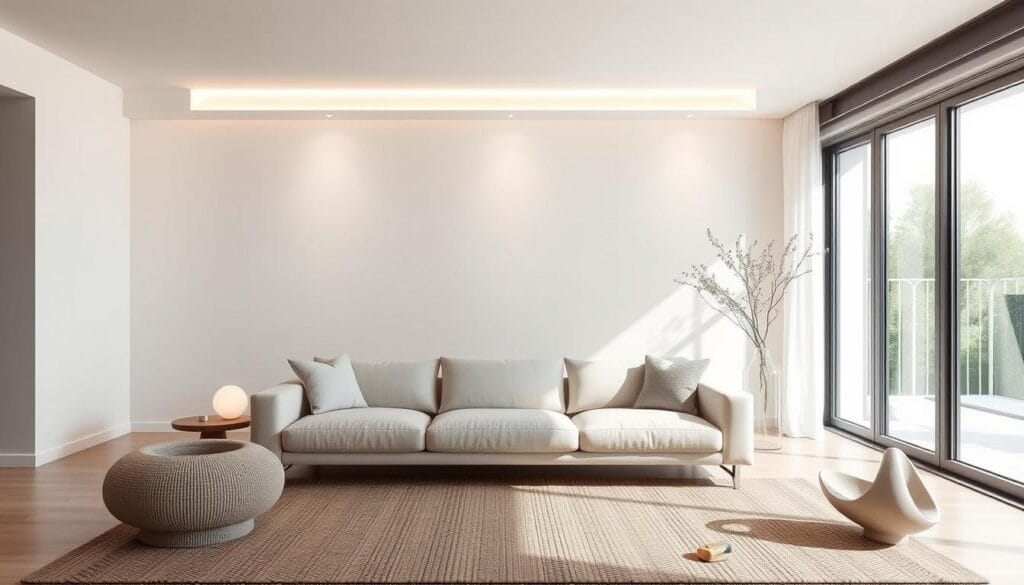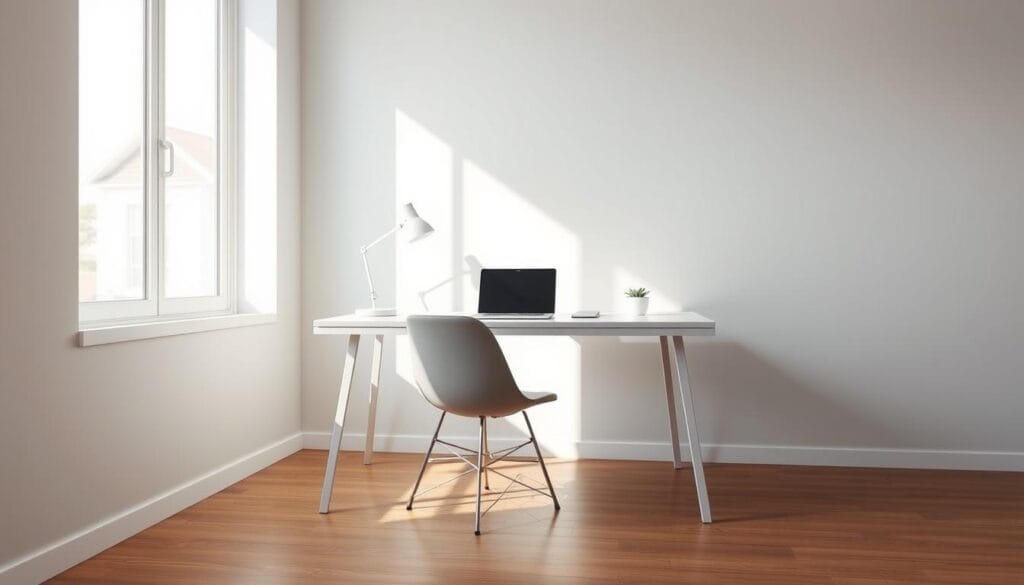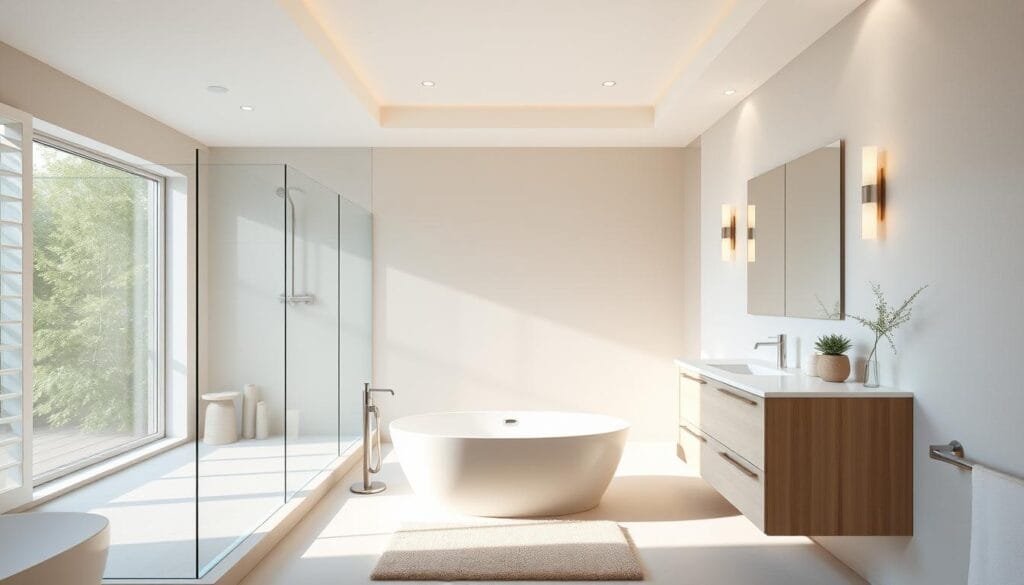Have you ever entered a friend’s house that felt like a peaceful retreat? With soft light coming in and wide-open spaces free of mess? That sense of calm can be yours too, not just in fancy pictures or magazines. It’s the heart of minimalist design for your place.
Minimalist design has gripped our hearts since the 1960s. It’s still popular for a good reason. It’s all about simplicity, with clean lines, practical spaces, and soothing colors. Picture a living room where every furniture piece matters, a kitchen that feels open with floating shelves, and a clutter-free bedroom.
Think about how natural light and well-chosen decor can change your home. We aim for a cozy yet practical space where everything fits perfectly. Are you ready to bring simplicity into your home? Let’s start this design adventure, creating spots that comfort and inspire.
Understanding Minimalist Home Design Principles
Minimalist home decor means more than just a trend. It’s about embracing simpler, purposeful living areas. It came about in the 1960s and 1970s, bringing forward a look defined by clean lines and neutral colors. It roots back to art movements after World War II, with a spike in popularity in the 1980s. This design values simplicity, function, and caring for our planet.
Key Characteristics of Minimalism
Minimalism is all about simplicity, practicality, and smart use of space. Our approach today uses simple shapes, sticks to neutral colors, and prioritizes efficiency. For example, minimalist rooms have only essential furniture. This often includes clever storage to keep things tidy.
Benefits of Minimalist Design
Minimalist design brings many perks, like a calm and useful space. Studies suggest it clears our minds and cuts down stress by doing away with extra clutter. Focusing on both function and beauty, it boosts efficiency and creates a calm look. This helps make our homes a peaceful place.
Common Misconceptions
Even though minimalism is becoming more common, some still get it wrong. One myth is that minimalist design feels cold or not welcoming. But, if you use a mix of textures and place things deliberately, minimalism can be cozy and inviting. The idea of “less is more” isn’t about missing out. It’s about making every piece stand out with its simplicity.
Key Elements of Minimalist Home Decor
Minimalist home decor aims for a balance between looks and use. It relies on minimalist furniture, color schemes, and home architecture to make spaces peaceful yet useful. We’ll dive into the key parts more deeply next.
Simple Color Palettes
Choosing simple color palettes is crucial in minimalist decor. Neutral shades like white, beige, and gray create a calm, open feel. Research shows 60% of people prefer these calm colors over bright, busy patterns. They reduce visual mess and help clear your mind.

Functional Furniture Choices
Quality and multi-use are key for minimalist furniture. Unlike typical rooms with 10-15 items, minimalist rooms have only 4-5 key pieces. This not only cuts down cleaning time by 30% but also frees up space to enjoy. The aim is to have items that fit your life but don’t crowd your space. For tips on choosing the right pieces, check this link.
Textures Over Patterns
Adding texture instead of patterns is a great move in minimalist homes. Using natural wood, stone, and fabrics adds depth and coziness without chaos. About 75% of minimalist designs use these materials for a welcoming yet simple look. Choosing textures helps keep things simple and boosts the home’s beauty.
Creating Space with Layout and Design
Using a minimalist layout design can make your home feel peaceful and roomy. We’ll look at three key ways to enlarge your living space. 🏡
Open Floor Plans
Open floor plans are a big part of minimalist design. They remove unnecessary walls, making spaces blend together smoothly. This makes your home look bigger and helps people connect more.
Letting more natural light in through these open spaces makes folks feel happier and sleep better. With an open plan, your home is not just bigger. It also has a bright, healthy vibe.
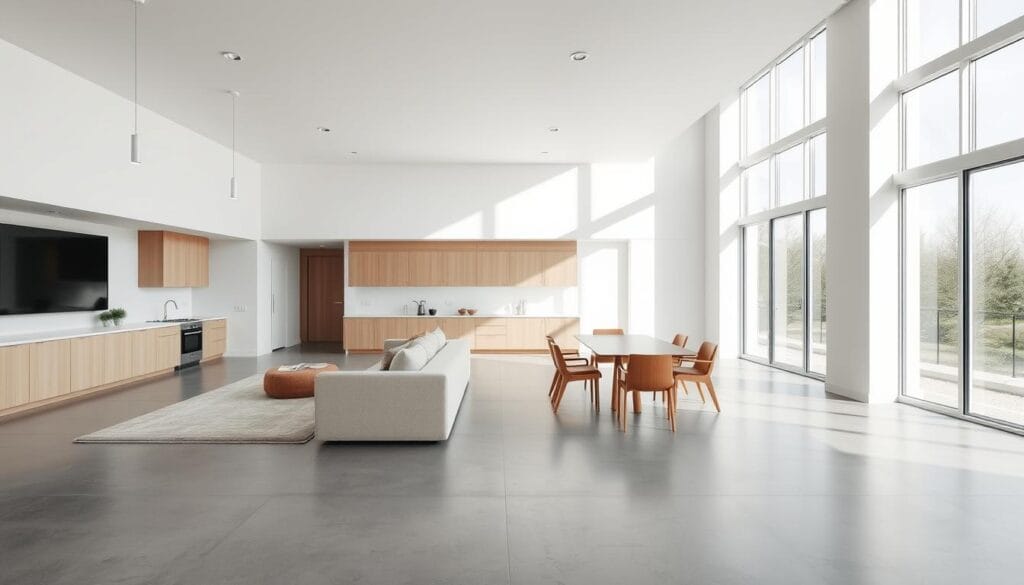
Multi-Functional Areas
Making areas in your home serve more than one purpose increases its usefulness. Imagine an office that turns into a guest room, or a dining area that’s also a workspace. Using items like storage ottomans and tables that get bigger helps keep clutter away. This smart use of space fits perfectly with minimalism.
Integrating Nature
Adding natural elements to your home brings calmness and balance. Using materials like wood and stone makes spaces more tranquil and lovely. Also, having a tidy space helps your mental health, making you feel more at ease and focused. By including nature in your home, you enhance its beauty and promote well-being.
Choosing the Right Materials
Picking the right materials is key for a true minimalist look that’s also green and stylish. We aim at sustainable minimalist designs that lessen our environmental impact but still look clean and beautiful. It’s important to know how textiles affect the room’s feel, as they can make it warm and cozy.
Choose quality materials to ensure longevity and add value to your minimalist spaces.

Sustainable Options for Minimalism
Choosing sustainable materials is good for both the look and the environment. Like reclaimed wood, it looks great and doesn’t hurt the forest. Also, eco-friendly porcelain stoneware is both durable and stylish for minimalist homes.
When we pick these materials, we support a style that cares about beauty and the planet. Check out sustainable minimalist design for more tips.
How Textiles Impact Design
Textiles are important in minimalist design, adding depth and warmth without being too much. Use natural fibers like cotton, linen, and wool for things like upholstery and rugs. These materials feel great and make the room comfy and welcoming.
Investing in high-quality textiles makes your home look and feel better.
Choosing Quality Over Quantity
In minimalist design, it’s all about quality, not quantity. Materials like solid wood and natural stone are not only strong but also timeless. High-quality furniture tends to last longer than the cheaper kinds, which fits the minimalist idea of keeping things for a long time.
This way, there’s less waste and less demand for cheap, throwaway items. It leads to a more sustainable way of living. You can look into more ideas on materials and textures for your minimalist home.
Light and Ambiance in Minimalist Homes
Lighting is key to the perfect minimalist feel. It combines natural light and smart fixture choices. This blend makes spaces not just useful, but also calm and welcoming.
Maximizing Natural Light
More natural light in our homes makes us happier and more productive. Big windows or large glass areas are great to let in lots of light. Rooms facing south get the best light all day.
Using mirrors smartly can make a room brighter and feel bigger. They reflect light around, enhancing the space.
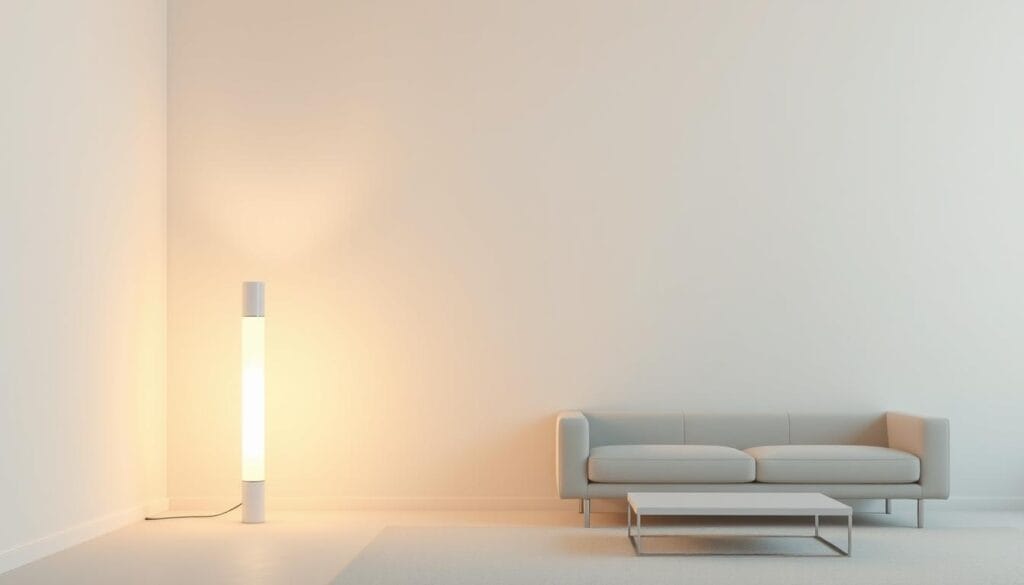
Strategic Lighting Fixtures
Choosing the right lighting fixtures can change a room’s feel. Use different kinds of lighting to make a space work well and look good. Warm lights make areas cozy, while cool lights are modern and fresh.
The Role of Color in Lighting
The color of light is important for setting a room’s mood. Warm colors are great for relaxing in living rooms or bedrooms. But cooler colors work better in workspaces or kitchens, keeping you focused.
Adding dimmers lets you change the light for any need. It makes it easy to adjust the room’s feel whenever you like.
Essential Furniture for Minimalist Interiors
Choosing the right furniture is key for a minimalist home. It’s about finding pieces that look good and are useful. This keeps your space open, balanced, and practical.
Must-Have Minimalist Furniture Pieces
In a minimalist home, some furniture is must-have. Think simple sofas and practical coffee tables, offering comfort and utility without taking up too much space. Also, pieces that serve more than one purpose, like storage chairs or dressers with mirrors, can free up a lot of room.
Custom Built-Ins vs. Ready-Made
Choosing between custom and ready-made furniture is a big decision for minimalists. Custom pieces are made to fit your space and style perfectly. Ready-made options are quick to get and usually cost less. Custom items can also be greener, cutting down your carbon footprint significantly.
The Importance of Scale
Getting the size of furniture right is super important in minimalism. The right size furniture can make a room feel bigger and clearer. It keeps things looking balanced and makes minimalist design more appealing. Choosing sleek furniture can also make your space seem larger.
| Aspect | Custom Built-Ins | Ready-Made |
|---|---|---|
| Cost | Moderate to High | Low to Moderate |
| Availability | Made to order | In stock |
| Quality | High | Varies |
| Sustainability | High (up to 30% reduction in carbon footprint) | Variable |
| Lifespan | Up to 10 years longer | Typical lifespan |
| Space Efficiency | Bespoke fitting | Standard sizes |
Practical Tips for Decluttering
Creating a clean, simple home might seem hard, but it’s totally doable with the right steps. Let’s look at how to declutter, organize minimally, and use space wisely. This way, you can turn your place into a calm retreat!
Strategies for Effective Decluttering
One smart way to start getting rid of clutter is the “4-box method.” This method helps you decide what to do with your stuff using four categories: Donate/Sell, Garbage, Recycling, and Bring Home. Placing items in specific boxes makes it easier to keep track and stay focused.
Just clearing off counters for 15 minutes can make a big difference. A timer can also help you fill a donation bag quickly. Also, using the “One In, One Out” rule keeps things balanced by replacing old items with new ones.
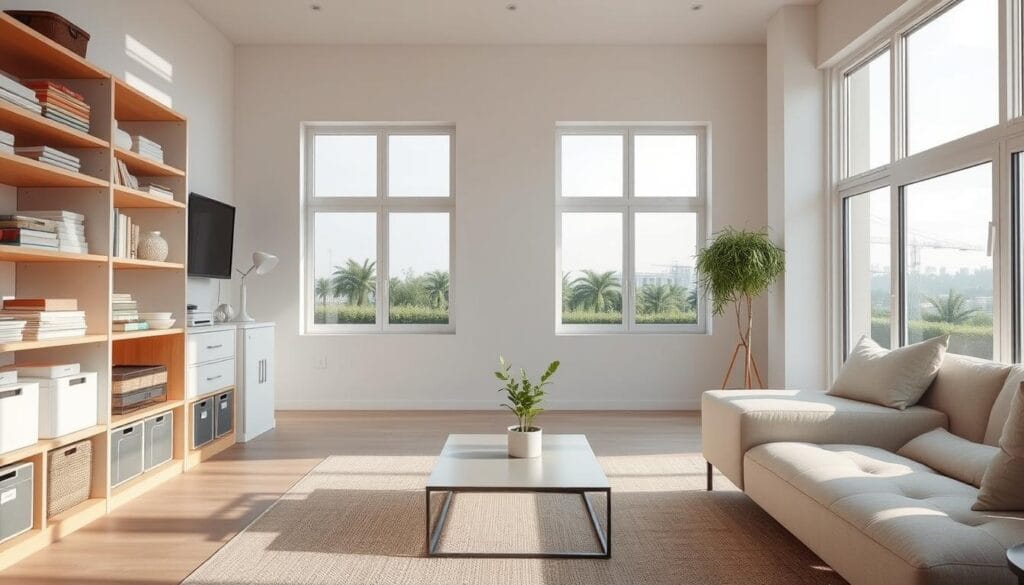
Organizing Techniques for Small Spaces
Organizing a small space well requires some clever strategies. Start with one spot at a time to not get overwhelmed. Keeping drawers tidy can save up to 30 minutes a week. And don’t forget to check out ways to make a small living room look.
Using items that serve more than one purpose can make the most of your space. An “inbox” for papers can help stop piles from growing. Each year, unchecked paper can grow by 25%.
The One In, One Out Rule
The “One In, One Out” rule is a great tool to stop clutter. With this rule, every new thing means something old leaves. It works for clothes, kitchen tools, or decorations. This keeps your space clear and useful.
Following this rule might mean getting rid of 365 items a year by just focusing on one item each day. Stick with it, and soon you’ll see your home becoming more organized.
Using these decluttering, organizing, and space-saving tricks can help make your home neater and more beautiful. Plus, it can bring you peace of mind and less stress. Let’s start now and watch how these tips can change your home!
- 4-box method: Use four categories: Donate/Sell, Garbage, Recycling, and Bring Home.
- 15 minutes: Time to clear flat surfaces for quick impact.
- 30 minutes/week: Saved by regularly organizing drawers.
- One In, One Out: For each new item, remove an old one.
- 365 items/year: Removed by focusing on one item daily.
Outdoor Spaces and Minimalism
Using minimalist ideas outside can make peaceful and useful areas that match the inside of your home. Focus on what’s necessary and how things work to make outdoor spots inviting. Let’s discover some simple garden ideas and how to blend them with indoor minimalism.
Designing a Minimalist Garden
When making a minimalist garden, think about structured plants and simple materials. Choose shapes and lines that are clean. This will bring order and balance. Picking plants from the area can lower how much you need to take care of them. This also increases your home’s natural charm. Remember, less is more. Use empty spaces to show off openness and peace.
Functional Outdoor Furniture
Choose outdoor furniture for a minimalist garden that looks simple and can handle the weather. Teak wood is great for its strength and ability to resist weather. It looks good in a minimalist garden, too. Make sure the furniture’s design is simple and each piece has a purpose. This will make your outdoor area more useful and organized.
Integrating Indoor and Outdoor Living
To smoothly join indoor and outdoor areas, think about a design that mixes the two. Use the same colors and materials inside and outside. Think about using one color scheme and natural stuff like wood and stone. Hidden lights can bring in warmth and highlight special parts of the design. This makes the whole space welcoming and unified.
With these simple garden tips and careful planning, you can make outdoor areas. They will be not only eye-catching and practical but also a real part of your minimalist home.
Budget-Friendly Minimalist Design Ideas
Creating a minimalist home on a budget doesn’t mean you have to sacrifice style. Many stunning minimalist areas are made through simple, affordable ways. These involve both creativity and practical skills. By combining thrift shopping and do-it-yourself projects, you can achieve a timeless, minimalist home affordably.
Thrift Shopping for Minimalist Decor
Thrift shops are full of potential for those who love minimalist design on a budget. With patience and a sharp eye, amazing pieces that fit a minimalist style can be found. Not just furniture, but also accent items that enhance minimalist neutral colors. Consider open shelving like steel-and-glass to make kitchens feel spacious. Even inexpensive items from IKEA can make areas seem brighter and more open.
DIY Minimalist Projects
Doing minimalist design projects yourself is enjoyable and helps save money. Painting walls in neutral tones or making your own minimalist artwork can change a room. Using what you already have is cheaper than buying new. With just a paint update or new handles, old furniture can look great again in a minimalist setting. Creating things like simple floating nightstands or tulip tables can add style to bedrooms or dining rooms affordably.
Cost-Effective Design Tips
Choosing wisely and focusing on functionality are key to cost-effective minimalist design. Opt for furniture that serves more than one purpose, like a sofa bed, to save space and money. Appreciate empty space and choose quality items over having many things. This keeps your home feeling serene and tidy. Add plants and use natural light to make your space feel peaceful and simple. Finally, picking durable, low-care materials like concrete flooring can give a stylish, minimalist look without much effort.

